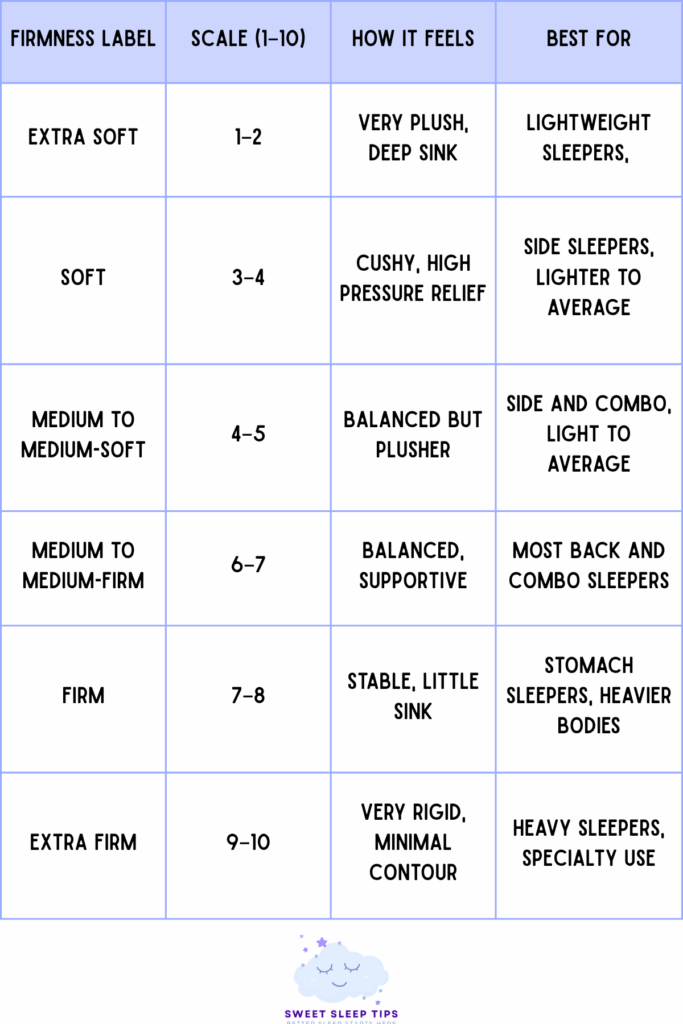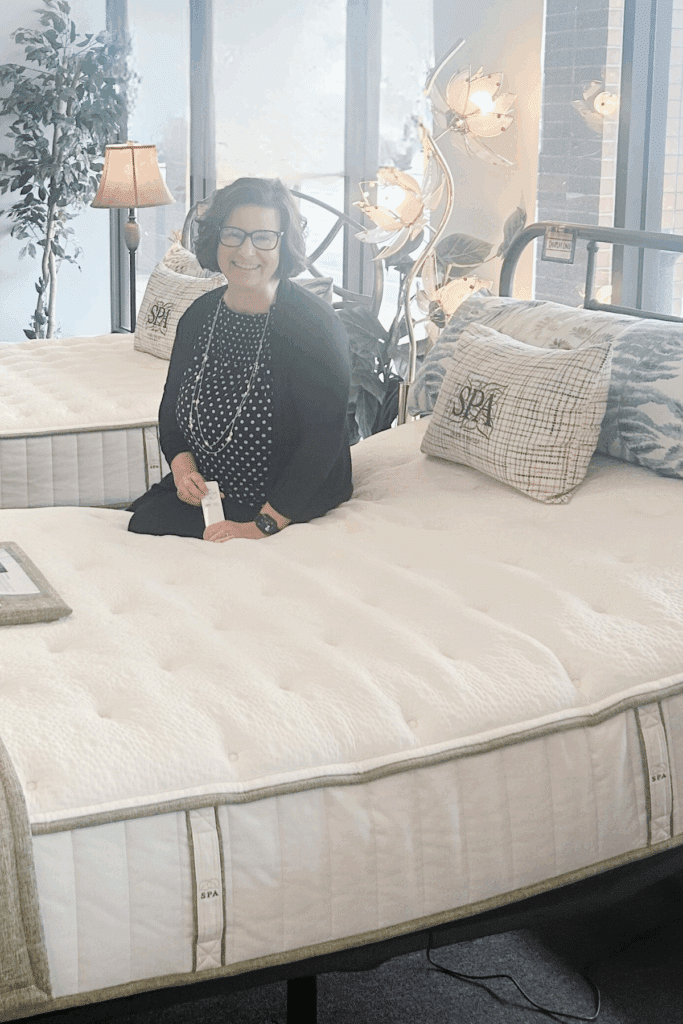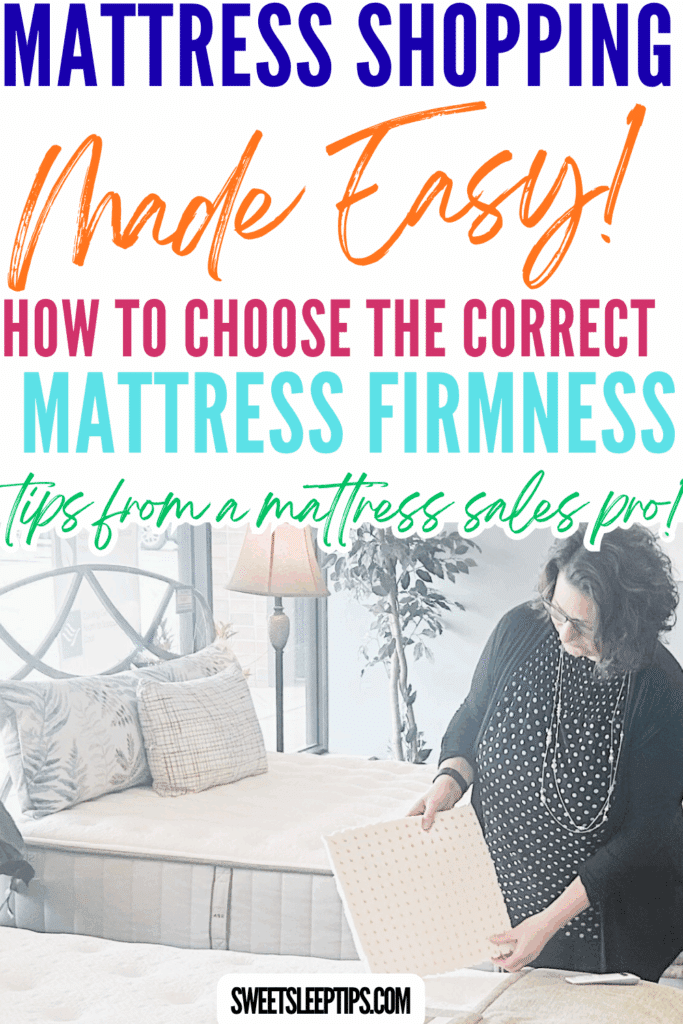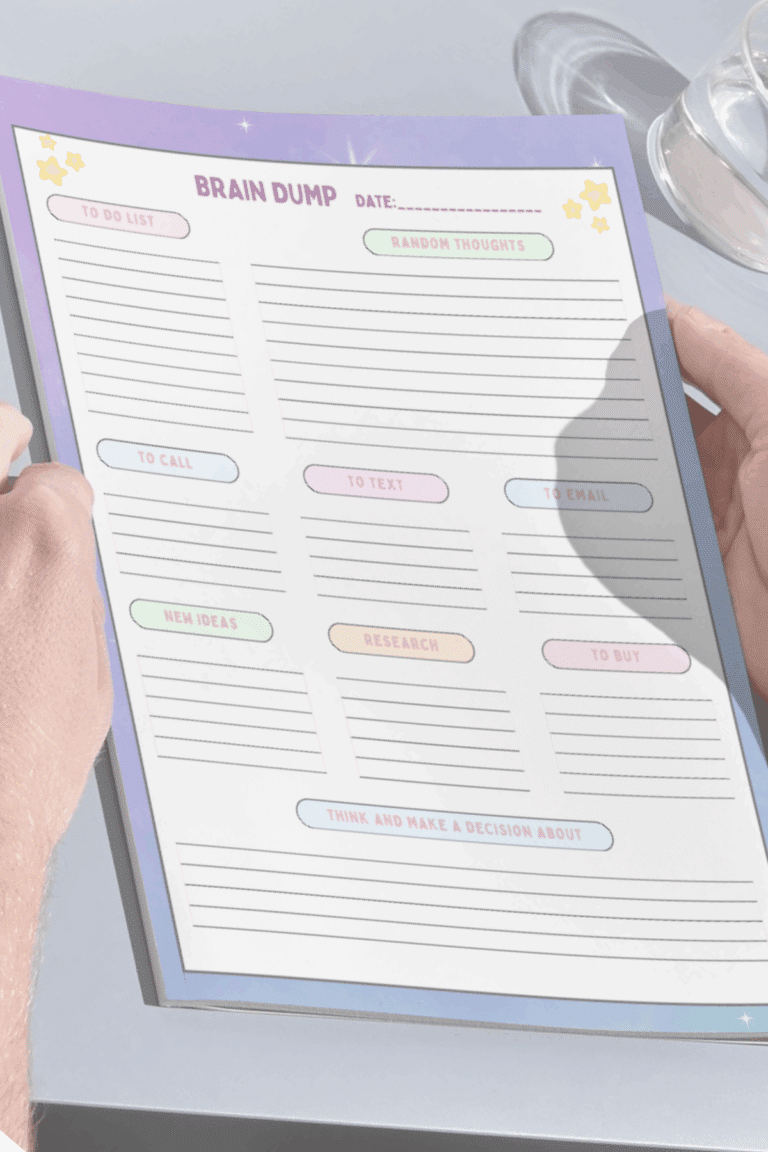How to Choose the Correct Mattress Firmness From a Mattress Pro
How to choose the correct mattress firmness can feel confusing, but after 25 years of helping people shop for mattresses, I’ve seen firsthand what works and what doesn’t. Keep reading to learn my mattress shopping tips, practical advice, and expert guidance so you can find the perfect mattress for your sleep style and comfort needs.
I may earn a small commission for affiliate links in this post at no extra cost to you. Please read my privacy policy and privacy page for more information. As an Amazon Associate, I earn from qualifying purchases.
After more than 25 years of helping people find the perfect mattress, I’ve seen firsthand just how confusing mattress shopping can be — especially when it comes to understanding mattress firmness.
Soft, medium, firm… I totally understand that it’s easy to get overwhelmed and wonder which one is right for you.
That’s exactly why I wanted to write this post: to share what I’ve learned over decades of mattress sales and make it simple for you.
To help you get started with mattress shopping, I’ll explain the different mattress firmness levels, what each feels like, and give you practical tips to shop with confidence so you can find the mattress that’s truly the best fit for your sleep.
So, are you ready to get started? Great! Grab a snack, settle in, and let’s get into it!
Mattress Firmness Scale 1 to 10 Explained so You Can Compare
Imagine mattress firmness on a scale from 1 to 10, where 1 is the softest and 10 is the firmest.
The first thing you notice when you lie down is the initial feel — how soft or firm the surface feels in those first few seconds.
Keep in mind, support is related to firmness, but it’s not the same thing.
Two key points right away:
- The same mattress feels softer to a heavier person and firmer to a lighter person.
- Brand labels vary. One brand’s “medium” can feel like another brand’s “medium-firm.” Use the scale as a guide, not a rule.
Very soft or very firm mattresses rarely work for most people long-term.
Too soft can let your hips drop, too hard can create pressure points.
Medium-firm, around 4 to 8, is the safe starting point for many sleepers because it balances cushioning and support.
What each firmness level feels like and who it fits
- Extra Soft (1–2): Very plush with deep sink. Think of sinking into a pillow cloud. Great pressure relief, but many people bottom out and lose alignment. Works for very lightweight side sleepers only, and even then, it is tricky.
- Soft (3–4): Cushy and pressure-relieving. Good for side sleepers who need give at the shoulders and hips. Light and medium-weight sleepers may like this, but heavier bodies often sink too much.
- Medium to Medium-Firm (5–7): Balanced contour and support. Enough cushion for pressure points, enough pushback to keep the spine straight. This range fits a wide mix of back, side, and combination sleepers.
- Firm (7–8): Stable with little sink. Best for stomach sleepers who need to keep the hips up, and for heavier sleepers who need stronger support.
- Extra Firm (9–10): Very rigid with minimal contour. Some heavier stomach sleepers like this, but many people find it too hard for pressure relief.
Typical matches by position and body type:
- Side sleepers often prefer 1 to 6.
- Back sleepers often prefer 4 to 8.
- Stomach sleepers usually need 4 to 8.
- Heavier bodies usually need firmer support to avoid deep sink.
Firmness vs support: why both matter for comfort
Firmness is the surface feel.
Support is how well the mattress holds a neutral spine and supports your overall body.
Keep in mind, you can have a mattress that feels soft on top, yet still supports you if the core is sturdy.
Key parts of support:
- Coil system or foam core: This is the engine that holds you up.
- Comfort layers: These are the top foams or fibers that contour to your shape.
One thing a lot of my customers assume is that a pillow top does not offer support.
This is really not the case.
If the coil system is strong or the core foam is dense, you can enjoy plush comfort and still keep your spine aligned.
In fact, I sleep on a two-sided pillowtop with a great pocketed coil system.
Look for balanced contouring so your shoulders and hips sink just enough.
Avoid extremes on either end.
The middle often works best for day-to-day comfort and alignment.
Why medium around 4 to 7 works for most sleepers
I often start shoppers with a comfort test by having them try a firm, medium, and soft when they are unsure of their comfort.
Medium is often the most popular as this offers enough cushion to reduce pressure and enough support to keep the hips from dropping.
It also suits a wide range of sleeping positions and is ideal for couples.
If you are in doubt:
- Start at 4 to 7.
- Adjust one step softer for more pressure relief.
- Adjust one step firmer for more lift and stability.
- Fine-tune with a topper if you need a touch more cushion.
How to Choose the Correct Mattress Firmness for Your Body and Sleep Position
Use this simple path.
Match your position and body weight first, then adjust one step softer or firmer based on preference.
Alignment comes first, comfort comes next.
- Side sleepers: Start at 2 to 6.
- Back sleepers: Start at 4 to 7, possibly up to 8 if you like a firm feel.
- Stomach sleepers: Start at 4 to 8.
- Combination sleepers: Start at 4 to 8 for easier movement.
Remember, weight changes feel:
- Lighter bodies feel mattresses firmer.
- Heavier bodies feel mattresses softer.
I remind my customers when shopping (although it can feel strange in a store, it’s important!), always test in your real sleep positions.
Lie on your side, back, or stomach and pay attention to your hips, shoulders, and lower back.
Your spine and curve in your back should feel straight and supported, with no pinching or pressure hot spots.
Side sleepers: relieve shoulder and hip pressure with the right softness
Side sleepers need enough give so the shoulder and hip nest into the bed without hitting a hard stop.
That usually means 2 to 6 on the scale.
What to look for:
- A pressure-relieving top layer, like latex, gel memory foam, or soft foam.
- A supportive core, like a coil system or heavy foam core, underneath, so you do not bottom out.
Quick tip: Lie on your side for a few minutes. If your arm goes numb or your shoulder feels sore, the bed is probably too firm. If you feel stuck or your hip dives, go a bit firmer or choose a model with a stronger support system.
Back sleepers: keep a neutral spine with medium to firm
Back sleepers do best when the curve of the lower back feels lightly supported.
Too soft and your hips sink, too hard and you get pressure in the shoulders and low back.
Target 4 to 7 for most, and up to 8 if you want a firmer feel or have a heavier build.
How to test it:
- Slide a hand under your lower back. You should feel gentle contact, not a big gap, and not hard pressure.
- Check that your hips and shoulders are level with your mid-back. No sagging, no arching. Your body should feel perfectly supported as a whole
Note: Spend a few minutes on your back and notice your breathing and comfort. If your lower back feels exposed, go a touch softer. If your hips sink, go firmer.
Stomach or combination sleepers: prevent hip sink and keep balance
Stomach sleepers need to keep the beltline level so the lower back does not bow.
This usually means 5 to 8.
Quick test: Lie on your stomach and check your beltline. If it drops, you need more firmness.
Note: Combination sleepers move around, so pick a 4 to 7 that lets you turn easily without feeling stuck. Responsive foams or hybrid designs help with mobility and reduce effort when changing sides.
Body weight guide: under 130, 130 to 230, over 230 pounds
Feel changes with weight because of how much you compress the foam and core.
- Under 130 pounds: You will feel mattresses firmer, so you may like 2 to 4 for side sleeping or 4 to 6 for back and combo. Softer tops help you sink just enough for pressure relief.
- 130 to 230 pounds: Most people in this range land well between 4 and 8 based on position, with medium to medium-firm as a solid sweet spot.
- Over 230 pounds: You usually need 8 to 10 to prevent deep sink and keep alignment, especially for back and stomach sleeping. Multiple comfort layers can soften the surface without losing support.
A well-built hybrid with strong coils and a quality foam top is often a good match for heavier bodies who still want a hint of cushion.
Health and Lifestyle Factors That May Change Your Firmness Choice
We do not live in a lab.
Real bodies change after work, sports, and injuries.
After years of working in a mattress store and hauling beds, I have had my share of shoulder, hip, and low back pain.
It changed my own comfort target; I now prefer more cushion on top with a supportive base.
Your story matters too.
Focus on three areas: back pain, pressure points, and partner needs.
You can dial in your firmness with small changes, not always a whole new bed.
If you have back pain, aim for support without harsh pressure
Back pain usually needs stable support with moderate contour.
Start between 4 and 8 based on your position and weight.
Skip extremes that are very soft or very hard.
How to test:
- Lie in your worst-pain position.
- Stay there 10 to 15 minutes.
- You should feel steady support under the lower back, with no sharp pressure.
If your hips sink, go firmer. If your back feels jammed or pinched, go a bit softer on the top layer.
If shoulders or hips ache, choose pressure relief with a supportive core
Sore joints often need a softer comfort feel, but still need a stable core to prevent sagging.
For side sleepers with shoulder or hip pain, a 2 to 6 comfort feel can help, paired with strong support underneath.
Helpful tweaks:
- Zoned designs that feel a touch softer at the shoulders and firmer at the hips.
- A softer topper on a supportive mattress.
My personal setup is a double pillow top over a strong pocketed coil system.
I get plenty of cushion at the shoulders and hips, and the coils keep my spine neutral.
This balance keeps me comfortable even after long days of lifting.
Sharing the bed: couples with different firmness needs
Two people, two opinions.
Here are practical ways to meet in the middle.
- Choose a medium feel if your needs are close. It is the most flexible starting point.
- If you are far apart, consider a split king, two twin XL mattresses with different comfort levels. Each person gets their own firmness, and you still share the frame.
- Test motion transfer and edge support together. If one partner moves a lot or sits on the edge, these features matter.
Talk through must-haves before you shop.
Agree on core needs, pressure relief for one person, firm support for the other, and pick materials that support both.
Pro Tips for Testing Mattresses In-Store and at Home
A few smart checks can save you from buyer’s remorse.
- Wear comfy clothes: You should move freely and lie how you sleep at home.
- Use your normal pillow height: Ask for a similar pillow to try to what you are used to at home.
- Lie for 10 to 15 minutes: Short sits do not reveal pressure points. Make sure you
- Check alignment: Ask a friend or the salesperson to look at your spine. It should look straight on your side and follow your natural curve on your back.
- Do the beltline check: For stomach sleepers, your beltline should not drop.
- Scan for hot spots: Shoulders, hips, and lower back should feel cushioned, not pinched.
- Move around: You should turn without fighting the surface.
- Use the trial wisely: At home, keep the tags and protect the mattress. Note comfort after full nights, not quick naps.
FAQs I Hear Every Week in the Mattress Store
- Is soft bad for my back? Not always. If the core is supportive and your hips stay level, a soft top can be fine. Many side sleepers do great with softer comfort layers.
- Is a firm always better for support? No. Support comes from the core, not just how hard the surface feels. A firm bed can still let your hips sink if the core is weak.
- Can I fix a bed that is a bit too firm? Yes. A quality topper can add pressure relief, especially for side sleeping.
- What if my partner and I disagree? Try medium as a starting point, or go with a split king so each of you gets your own comfort level.
- How long should I test a mattress? Spend at least 10 to 15 minutes in your main sleep positions. At home, use the full trial period before you decide.
Final Thoughts
Knowing how to choose the correct mattress firmness is one of the most important steps in mattress shopping.
With my years of experience helping people find the perfect mattress, I can tell you that understanding what soft, medium, and firm actually feel like will save you time, frustration, and ensure you get the sleep you deserve.
By using these tips and paying attention to your sleep style, room layout, and comfort preferences, shopping for a mattress becomes far easier and more confident.
Need some more help with your night routine for better sleep? Grab a free printable checklist below, and we’ll send it straight to your inbox.
Your Turn
Now it’s your turn! Take a look at your bedroom, think about your sleep habits, and use these mattress shopping tips to narrow down the right firmness for you. Let me know in the comments below if you have any questions on how to choose the correct mattress firmness.
RELATED POSTS:
- How to Choose the Right Mattress Type for Better Sleep
- How To Choose The Right Size Of Mattress Buying Guide
- Best Bed Sheets for Hot Sleepers: What to Buy to Stay Cool and Sleep Well
- The Best Sleep Investment I’ve Ever Made (and Why It’s the BedJet Sleep System)
- Cozy Bedroom Ideas for Better Sleep: Easy Tips to Create a Sleep Sanctuary
- Top 15 Bedroom Essentials: My Must Have List for Better Sleep
- How to Sleep Faster and Wake Up Energized Every Morning
Hi, I’m Debbie, general manager of a mattress store chain with 25+ years helping people improve their sleep quality. At Sweet Sleep Tips, I share natural, practical sleep solutions, calming bedtime habits, and printable tools to help you fall asleep faster and wake up refreshed. My goal is to make better sleep simple, healthy, and stress-free.
Follow me on Pinterest, Instagram, and Facebook to stay up to date with all the latest Sweet Sleep Tips.




























Thank you for these tips about how to choose the correct mattress firmness. I especially appreciate your chart. That shows me at a glance that the mattress I’m sleeping on is the correct one for me. So kind of you to share your expertise!
Thank you for sharing this valuable information and tips! I find the mattress firmness scale to compare especially helpful. With the expert tips you shared here, we can really choose the correct mattress firmness.
What a helpful resource for choosing the best mattress firmness! So thorough and clearly explained. Pinning this for future reference!
I recently changed the mattress on our bed for health reasons. Your article would have been a very helpful resource, but thankfully I chose well after doing my research and now I can’t imagine my life without my new mattress!!
This is a very helpful guide for choosing the correct mattress. It really is tricky to find exactly the “right fit” for your sleeping needs. I’ll be sure to save this post for the next time I’m mattress shopping.